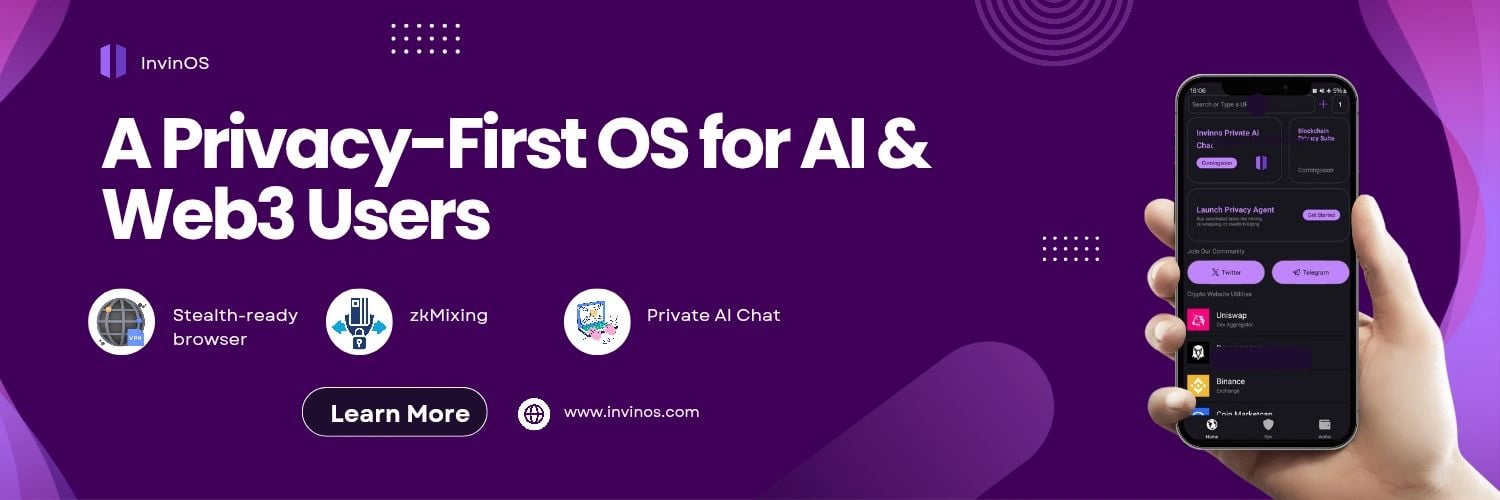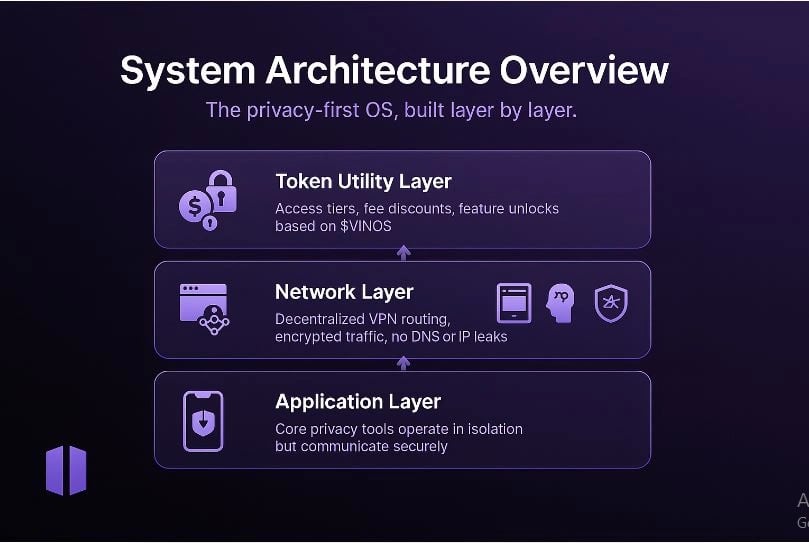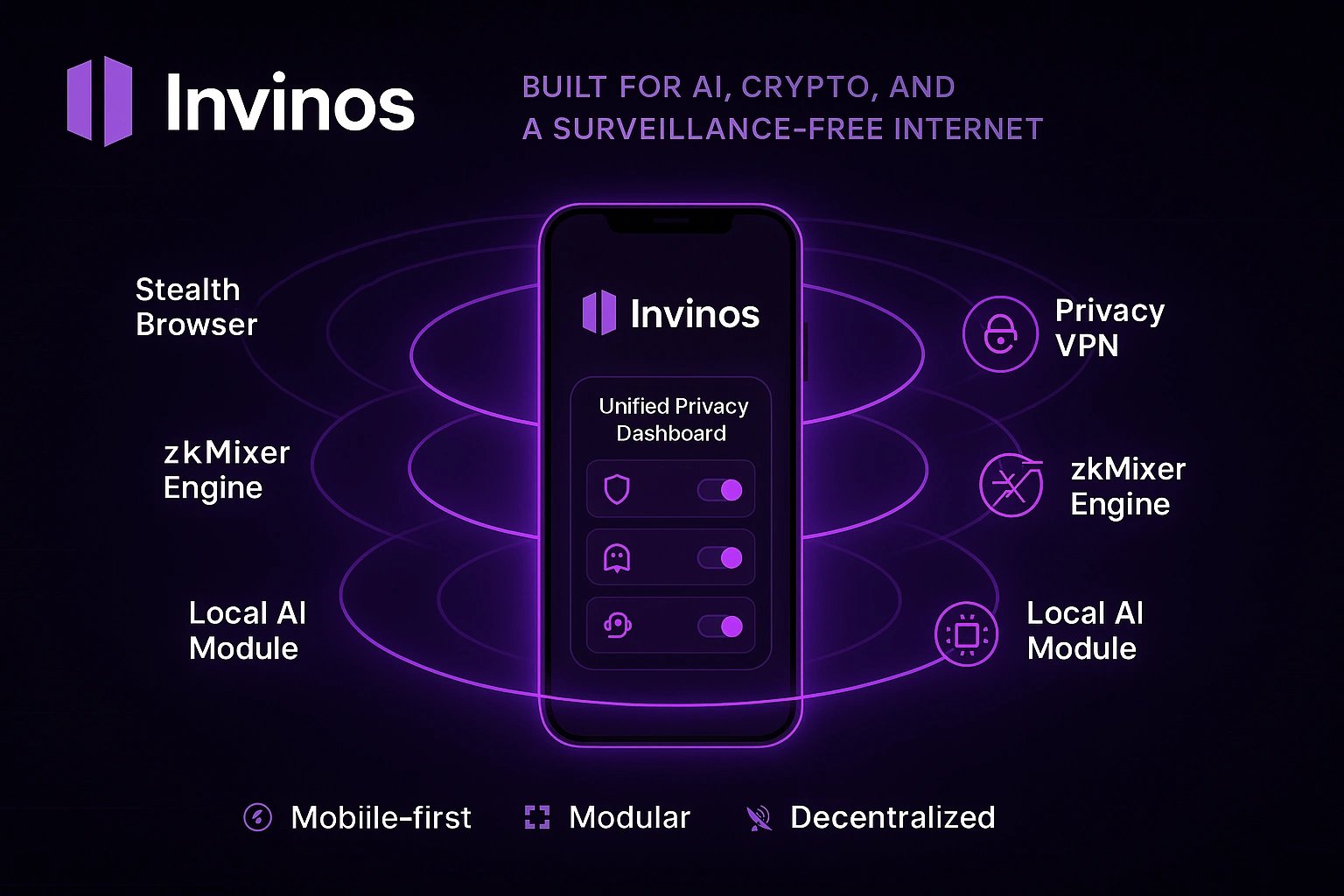订阅 wiki
Share wiki
Bookmark
INVINOS
INVINOS
Invinos is an AI and Blockchain Privacy Operating System designed to integrate encrypted AI tools, anonymous blockchain infrastructure, and decentralized applications into a unified system focused on user privacy. It aims to provide a platform for private digital interactions and transactions. [35]

Overview
Invinos is a mobile-first, privacy-focused operating system that supports secure interaction with AI tools, blockchain networks, and the internet. It integrates multiple privacy features—such as a tracker-blocking browser, decentralized VPN, cross-chain mixer, temporary wallets, and local AI inference—into a single cohesive environment. Built for Android devices, Invinos eliminates data exposure by default and operates without centralized dependencies or user identification. It supports private web browsing, untraceable on-chain transactions, and AI queries without external logging. The modular system allows users to activate only the necessary privacy tools while enabling layered protection.
Invinos was created in response to increasing digital surveillance and is intended for individuals who need robust privacy, such as DeFi participants, developers, and journalists. Its infrastructure emphasizes decentralization, user autonomy, and minimal data footprint, differentiating it from single-purpose tools like standalone VPNs or mixers. [1]
Architecture

Design Layers
Invinos is structured around six distinct design layers, each responsible for protecting a different aspect of digital interaction. Rather than relying on a single, unified system, its architecture separates functionality into specialized modules to minimize risk, limit metadata exposure, and prevent central points of failure. This modular structure is intentional, offering both security and adaptability.
Each layer supports three primary objectives: preventing traceability, eliminating metadata leaks, and enabling private, unrestricted use of the internet, financial tools, and AI systems. Whether handling web traffic, session data, wallet activity, or user identity, every component contributes to a broader system that adjusts to different privacy needs.
These layers are managed through a centralized dashboard for ease of access and coordination, but can also function independently depending on user requirements or threat level. This flexible framework allows Invinos to serve a broad range of users, from individuals looking for basic protection to professionals operating in high-risk environments. [2]
Network
The network layer forms the base of Invinos' privacy architecture, handling all outbound and inbound communication from the user’s device. Unlike conventional systems that rely on centralized ISPs or VPN providers, which can monitor or store user metadata, Invinos uses a decentralized, peer-to-peer VPN tunnel. This system routes internet traffic through multiple anonymous relays to prevent traceability.
Data packets are encrypted at several stages using multi-hop routing, ensuring no single node can view the origin and destination. DNS requests are resolved through anonymized channels to prevent domain-level tracking, and packet padding obscures size and timing, reducing the risk of traffic pattern analysis.
This layer prevents external services—websites, apps, and blockchain platforms—from detecting user location, device details, or correlated activity. It operates continuously and underpins all other modules in the system, serving as the primary barrier against surveillance. [3]
Browser
The browser layer in Invinos is designed to eliminate one of the most common surveillance sources: browser fingerprinting and behavioral tracking. Traditional browsers, even in private mode, expose data points like fonts, resolution, language settings, and input patterns, all of which can be used to build persistent user profiles. Invinos addresses this by creating a stealth browser that launches each session in a fully isolated, disposable environment.
Each browsing session is sandboxed, with no persistent cookies, cache, or identifiers carried over. Identifiable attributes such as screen size, time zone, and keyboard behavior are randomized per session. JavaScript execution is limited and monitored to block fingerprinting attempts, and tracking scripts are actively filtered out at both the network and application levels.
No session history is saved, and the browser does not rely on trust in third-party vendors or upstream services. Every page view is contained, unlinked from previous activity, and erased when the session ends. This approach ensures that users can navigate the web without exposure to profiling, targeting, or long-term data collection. [4]
Wallet & Asset
The wallet and asset layer in Invinos focuses on preserving on-chain privacy through ghost wallets—temporary, single-use addresses that are automatically generated for each financial session. These wallets are not tied to any central account or identity and are never reused, preventing the creation of a traceable transaction history.
To further obscure asset movement, Invinos integrates a transaction mixer called zkMixer. This system lets users deposit assets on one chain and withdraw different assets on another using a separate address, breaking the traceability between the two points. By doing so, the wallet layer protects users from clustering analysis, front-running, and identity-based targeting in decentralized finance and blockchain-based applications. [5]
Computation (AI)
The computation layer in Invinos addresses privacy concerns in AI usage by ensuring that all processing occurs locally on the device rather than in the cloud. Unlike most AI tools that log user prompts and responses, Invinos runs optimized language models directly on mobile hardware using quantized weights and GPU acceleration, eliminating external data exposure.
Prompts are encrypted during runtime, and no inference data is saved after processing, preserving the confidentiality of user input. This setup allows users to interact with AI models privately. Future updates plan to include support for encrypted prompt sequences, collaborative agents, and decentralized smart contract execution. [6]
Identity
The identity layer in Invinos removes the need for traditional accounts, emails, or social logins by using cryptographic methods to create anonymous and verifiable identities. Instead of tying identity to personal information, users interact through cryptographic proofs that maintain privacy.
With zk-Identity, individuals can demonstrate ownership of credentials, governance rights, or reputation without exposing wallet addresses or personal details. These portable identities can be recovered with key backups and support zero-knowledge proofs and Merkle tree attestations for secure, private verification. [7]
Interface & Dashboard
The interface and dashboard layer is the user’s local control center within Invinos. It displays the status of active privacy modules, provides real-time privacy metrics, and allows users to adjust settings based on their current needs. Features like the zkMixer can be enabled or disabled contextually without compromising privacy.
All dashboard functions operate locally, with no external communication or data storage. This design ensures that the user interface does not become a surveillance or information leakage source. [9]
Serverless
Invinos operates without centralized servers and relies instead on decentralized and local systems. It uses IPFS for distributing the app and metadata, decentralized VPN relayers for network routing, and public blockchains like Ethereum and Polygon for its zkMixer. Identity, proof, and wallet functions are handled through open-source cryptographic libraries, while AI tasks run entirely on-device using optimized inference tools.
This architecture makes Invinos resistant to censorship and reliant on no single point of failure. Its core functions remain accessible even if portions of the broader infrastructure become unavailable. [9]
Mobile-First
Invinos is built primarily for mobile use, with all components optimized to run efficiently on Android devices. Local AI models are quantized for performance, the browser uses GPU acceleration and isolated memory per tab, and the VPN layer runs on lightweight WireGuard-based relays to reduce battery usage.
The system operates without relying on background services or app store distribution. Users install it through decentralized APK links, with updates managed via IPFS manifests. This approach ensures comprehensive privacy protection is available on mobile devices, not limited to desktop environments. [36]
App Modules

Stealth Browser
The stealth browser in Invinos provides internet access without exposing user behavior or device details. Each session runs in an isolated container with no persistent storage, ensuring cookies, cache, and logs are erased when the session ends.
To block tracking, the browser randomizes device attributes like screen size and fonts, sandboxes JavaScript to avoid profiling, and filters out third-party scripts and trackers at the DNS level. This setup delivers a standard browsing experience, preventing sites from collecting identifying data. [10] [11]
Privacy VPN
Invinos’ VPN operates through a decentralized, multi-hop relay network that encrypts all traffic without relying on centralized servers. Each packet is layered with encryption and routed through rotating relays, preventing any node from linking its origin to its destination.
Encrypted DNS handling and dynamic IP masking further conceal browsing activity and location. The VPN runs automatically and requires no setup, allowing users to access online services without revealing their IP address or physical location, including Invinos. [12]
zkMixer
zkMixer is Invinos’ system for obscuring asset transfers by breaking the link between deposit and withdrawal activity. Users can deposit one token and later withdraw a different token to a separate address and chain, with no traceable connection.
The process includes batching transactions, randomized delays, and routing through temporary wallets. It offers strong practical privacy, with plans to add zero-knowledge proofs for formal unlinkability. Usage requires no account, login, or persistent state — each session remains fully encrypted and anonymous. [13]
Ghost Wallets
Ghost wallets are temporary blockchain wallets generated locally for single-use interactions. Unlike traditional wallets with persistent histories, these are created on the fly and discarded after use, leaving no long-term trace.
Ghost wallets rely on device-based entropy for key generation and are never linked to user identities or centralized storage. They support private dApp usage, asset transfers, and governance participation and can be paired with zkMixer to ensure transactions remain unlinkable. [14]
Anonymous DEX
The anonymous decentralized exchange (DEX) in Invinos enables cross-chain asset swaps without exposing user identity or trading patterns. It avoids public order books, mempools, and persistent wallet histories using session wallets, transaction relays, and cross-chain mixers.
The system prevents frontrunning, address clustering, and liquidity tracking, while supporting efficient trades and integration with DeFi tools. All swaps occur within a privacy-preserving environment, giving users full control over disclosure. [15]
Local LLM
Invinos integrates local language models that operate entirely offline, removing the privacy risks associated with cloud-based AI tools. Prompts and responses are never logged, stored, or transmitted, ensuring that user activity remains confidential. These models function within a sandboxed environment, and all session data is erased once the app is closed. This setup allows users to interact with AI securely, enabling tasks like translation, summarization, and text generation without external exposure. [16]
Context Lock
Context Lock is a temporary memory system for Invinos' local language models. It enables multi-turn conversations without persisting data. It maintains context only during an active session, allowing for more coherent interactions without retaining prompts or responses after the session ends. This design supports natural dialogue and reasoning while ensuring user intent and thought patterns remain private and unsaved. [17]
Privacy Dashboard
The Privacy Dashboard is Invinos' local interface for managing privacy features. It shows which modules are active, provides real-time privacy indicators, and allows users to enable or disable functions based on their needs. All operations occur on-device without external communication or data retention, ensuring the interface does not become a tracking or data exposure source. [18]
zk-Identity
zk-Identity enables users to verify attributes such as NFT ownership, token balances, or DAO membership without revealing their identity. It employs zero-knowledge proofs to create verifiable attestations that do not link to wallet addresses or personal data.
Proofs are generated locally, and on-chain verification occurs via smart contracts designed to maintain user anonymity throughout voting, access control, and selective disclosure processes. [37]
Governance
The governance module enables VINOS token holders to submit proposals, vote, and express preferences without exposing wallet activity or personal data. Voting uses privacy-preserving credentials from zk-Identity, ensuring no public record of participation or voter registry is created.
This approach supports decentralized, confidential governance, allowing the community to guide the platform while protecting privacy and preventing manipulation or coercion. [19]
VINOS
The VINOS token functions as the core economic layer of the Invinos platform, enabling decentralized, privacy-focused access to features like encrypted AI agents and zkMixers without relying on advertising or third-party control. Unlike purely speculative tokens, VINOS has embedded utility across all platform layers and supports a privacy-preserving economy that replaces traditional monetization methods.
Token usage naturally increases with interactions in privacy modules, fostering platform growth and rewarding holders through practical utility. VINOS enables an economy based on user freedom rather than data monetization, reinforcing a sustainable ecosystem for privacy-conscious users and supporting a digital environment owned by individuals rather than corporations [26]
Tokenomics
VINOS has a total supply of 100M tokens and has the following allocation:
- Liquidity Pool: 65%
- Ecosystem Development: 20%
- Marketing & Community: 10%
- Team: 5%
Partnerships
发现错误了吗?
